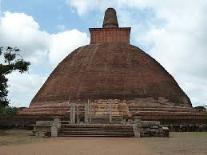Buddhist Pilgrimages in Srilanka

Democratic Socialist Republic of Sri Lanka or just Sri Lanka, is an island country located south of India in south Asia. It was formerly known as Ceylon and covers an area of 65,525 sq km. The topography of the country is mostly low with flat to rolling plains. Mountains are in the south-central interior. Sri Lanka's climate can best be described as tropical. The south-west monsoon brings rain to the western, southern and central regions from May to July whereas the north-eastern monsoon brings rain in the north and east between December and January.
Sri Lanka is described as 'a land like no other'. It attracts thousands of visitors every year, all come here to enjoy in their own way. Some come here to explore the culture and heritage while others intend to enjoy the beauty that nature has so benevolently bestowed upon this country. The one with an adventurous streak have their options wide open in this country.
Anuradhapura
oday's Anuradhapura is a huge park containing the ruins of the Great Monastery (Mahavihara) established 250 B.C.E. on the outskirts of the ancient
Singhalese capital. Anuradhapura is connected by an eight-mile (1 3km) pilgrim's path to Mihintale where the missionary Mahinda first preached
and where an excavated stupa can be visited. Disinterred earlier this century from the jungle growth of more than a millennium, Anuradhapura's
stupas, monastic ruins, sculptures, reservoirs, and a descendant of the original bodhi tree, provide an intense experience of ancient Buddhism.
Dominating the site are two vast stupas with characteristic Singhalese "bubble domes". The Thuparama, although much restored, is probably
the oldest monument in either India or Sri Lanka. The Ruwanweli Dagoba, is also heavily restored, and is clad in the undecorated white
plaster which differentiates Singhalese stupa architecture from the more ornate Indian style.
At Anuradhapura a wonderful convergence of the modern and the archaic may be experienced. On May and June full moon days, the festivals
of Wesak and Poson celebrate, respectively, the Buddha's birth, enlightenment and parinirvana, and the introduction of Buddhism to Sri
Lanka. At such festivals, Anuradhapura is enlivened by hundreds of thousands of devotees. For the modern day visitor, one of the great
pleasures is touring Anuradhapura on a rented bicycle.
Polonnaruwa
While Anuradhapura evokes the austerity of early Singhalese Buddhism, the later site of Polonnaruwa, wonderfully situated on Lake Topawewa,
offers an unparalleled view of medieval Buddhist sculpture and architecture. There the visitor may see the immense recumbent parinirvana
Buddha and the 25-foot (7.5m) rock-cut figure of Ananda standing by the head of the Master. There too is the colossal meditating Buddha,
and the famous sculptured portrait of the sage-king Parakramabahu overlooking the lake and in contemplation of a manuscript.
Equally dazzling are the early 13th-century monuments situated on the "Great Quadrangle". These include the classically proportioned
pyramidal brick stupa (Sat Mahal Pasada), the carved stonework of the "temple of the tooth relic" (not to be confused with the Temple
of the Tooth in Kandy) and the waving lotus-stem-shaped columns of the Nissanka Lata Mandapaya.
Just as Anuradhapura was abandoned by the 8th century, Polonnaruwa was finally conquered by the Tamils in the 15th century.
The art of Polonnaruwa represents the final flowering of Singhalese Buddhist art, still matchlessly preserved in land-locked jungle.
 Buddhist Pilgrimage Destination in India and Abroad
Buddhist Pilgrimage Destination in India and Abroad 